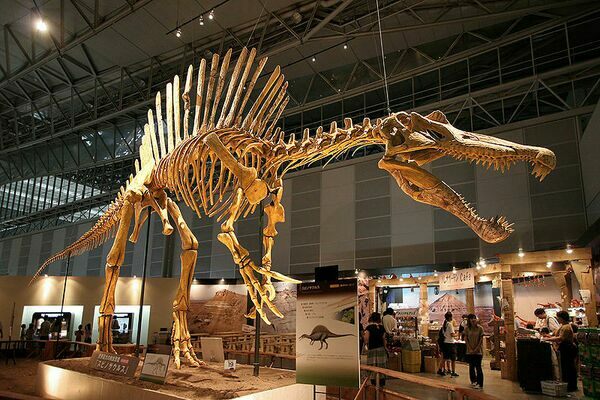This Specimen has been sold.
1.78" Spinosaurus Tooth - Real Dinosaur Tooth
This is an authentic, fossil tooth a Spinosaurus, the largest known meat eating dinosaur. It is from the Kem Kem Basin in Morocco and is Late Cretaceous in age, approximately 95 million years old.
About Spinosaurus
Spinosaurus is one of the most spectacular and horrifying creatures that ever stalked the Earth. Evidence suggests that it was semi-aquatic, so there was nowhere to escape from this fish- and dinosaur-eating monster. It belonged to a genus of theropod dinosaur, and lived in what is now North Africa during the Cretaceous period, about 112 to 97 million years ago. The original fossil evidence of S. aegyptiacus from Egypt was destroyed in WWII. More recently, relatively abundant Spinosaurus fossils have been found in the Kem Kem Beds of Morocco, and there are almost certainly multiple species present.
Spinosaurus is currently the largest of all known carnivorous dinosaurs, even larger than T. rex! While the exact size is debated ,recent finds and studies suggest Spinosaurus may have reached 41-59 feet in length and weighed in excess of 20 tons.
Spinosaurus had distinctive neural spines, extensions of the vertebrae that grew to at least 1.65 meters (5.4 feet) long. They were likely connected by skin to form a sail-like structure, but some authors suggest that the spines were similar in purpose and design to those of hump-backed mammals. Thermoregulation, display, and added weight while in the water are other likely explanations for this remarkable structure.
Spinosaurus's massive, nearly 6-foot skull is narrow like that of a modern crocodilian. Indicative of a piscivore, it had elongated jaws, conical, unserrated teeth, and raised nostrils. Isotope analysis of the teeth suggests a semi-aquatic lifestyle. It was likely a generalized and opportunistic predator, biased toward fishing.
Spinosaurus was a monster that lived among monsters. A picture of its life is pieced together with the gruesome contents of its meals and other macabre details of Cretaceous North Africa. Spinosaurus may have lived alongside similarly large dinosaurian predators such as Carcharodontosaurus, titanosaur sauropods, and the 33-foot long crocodylomorphs Stomatosuchus and Sarcosuchus.
A note on fossil Spinosaurus teeth:
Spinosaurus teeth are relatively common fossils, but large (3+ inches), well-preserved examples are rare. These large Spinosaurus teeth will often be heavily doctored. We’ve seen many examples where multiple partial teeth can been glued to together to create a larger fake tooth, or where enamel has been painted on. One giveaway to look for is a ring of sand around the middle of the tooth, usually glued on to hide a break. Sometimes this is a sign that multiple partial teeth have been composited, but other times it is used to disguise a badly done repair job.
While some teeth on FossilEra for sale have these types of repairs or restoration, we are careful to note it in the descriptions and they are priced accordingly.
Spinosaurus is one of the most spectacular and horrifying creatures that ever stalked the Earth. Evidence suggests that it was semi-aquatic, so there was nowhere to escape from this fish- and dinosaur-eating monster. It belonged to a genus of theropod dinosaur, and lived in what is now North Africa during the Cretaceous period, about 112 to 97 million years ago. The original fossil evidence of S. aegyptiacus from Egypt was destroyed in WWII. More recently, relatively abundant Spinosaurus fossils have been found in the Kem Kem Beds of Morocco, and there are almost certainly multiple species present.
Spinosaurus is currently the largest of all known carnivorous dinosaurs, even larger than T. rex! While the exact size is debated ,recent finds and studies suggest Spinosaurus may have reached 41-59 feet in length and weighed in excess of 20 tons.
Spinosaurus had distinctive neural spines, extensions of the vertebrae that grew to at least 1.65 meters (5.4 feet) long. They were likely connected by skin to form a sail-like structure, but some authors suggest that the spines were similar in purpose and design to those of hump-backed mammals. Thermoregulation, display, and added weight while in the water are other likely explanations for this remarkable structure.
Spinosaurus's massive, nearly 6-foot skull is narrow like that of a modern crocodilian. Indicative of a piscivore, it had elongated jaws, conical, unserrated teeth, and raised nostrils. Isotope analysis of the teeth suggests a semi-aquatic lifestyle. It was likely a generalized and opportunistic predator, biased toward fishing.
Spinosaurus was a monster that lived among monsters. A picture of its life is pieced together with the gruesome contents of its meals and other macabre details of Cretaceous North Africa. Spinosaurus may have lived alongside similarly large dinosaurian predators such as Carcharodontosaurus, titanosaur sauropods, and the 33-foot long crocodylomorphs Stomatosuchus and Sarcosuchus.
A note on fossil Spinosaurus teeth:
Spinosaurus teeth are relatively common fossils, but large (3+ inches), well-preserved examples are rare. These large Spinosaurus teeth will often be heavily doctored. We’ve seen many examples where multiple partial teeth can been glued to together to create a larger fake tooth, or where enamel has been painted on. One giveaway to look for is a ring of sand around the middle of the tooth, usually glued on to hide a break. Sometimes this is a sign that multiple partial teeth have been composited, but other times it is used to disguise a badly done repair job.
While some teeth on FossilEra for sale have these types of repairs or restoration, we are careful to note it in the descriptions and they are priced accordingly.
SPECIES
Spinosaurus sp.
LOCATION
Taouz, Kem Kem Basin, Morocco
FORMATION
Kem Kem Beds
SIZE
1.78" long
CATEGORY
SUB CATEGORY
ITEM
#94225
We guarantee the authenticity of all of our specimens.
 Reviews
Reviews













